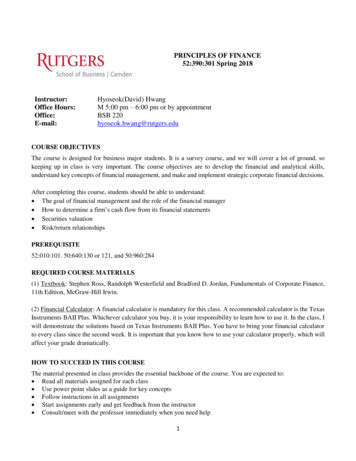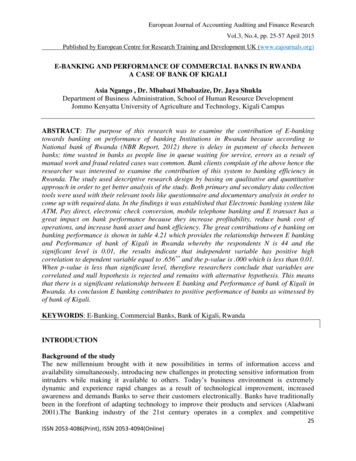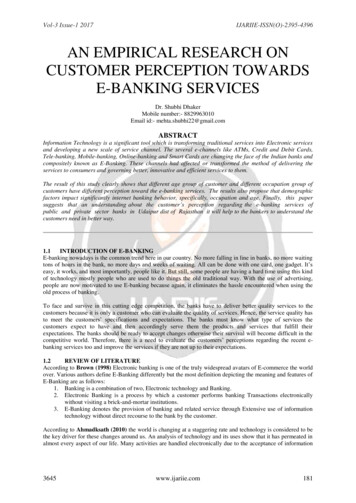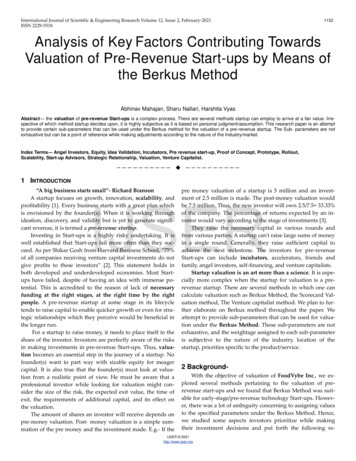
Transcription
The specialist in highly technical, market-drivenbanking and corporatebankingfinance trainingBankingCoursesBusinessValuationCoursesAll courses can be presented In-House or via Live Webinarweb: redliffetraining.co.ukemail: enquiries@redcliffetraining.co.ukphone: 44 (0)20 7387 4484
Advanced Negotiation Issues in M&ABrochure ContentLocation: LondonDate:Price: . VATBOOK NOWPUBLIC COURSES CourseAdvancedBlockchain and Digital Currency TechnologyOverview Advanced Debt Restructuring Anti Money Laundering - Financial Crime Compliance Asset Based Lending Bond Documentation Commercial Real Estate Debt Finance ISDA DOCUMENTATION Drafting & Negotiating Issues in Real Estate FinanceDocumentation IFRS 9 - The Latest Updates NEGOTIATING ISDA MASTER AGREEMENTS Negotiating & Issuing High Yield Bonds Advanced Negotiation & Structuring Issues in Real EstateFinance Term Sheets Real Estate Modelling Risk & Capital Management Under Basel III and IFRS 9 Securitisation & Structured Products: UpcomingRegulatory Changes CourseSecuritisation- The Structures, Legal Analysis andContentDocumentation Structured Trade and Commodity Finance Advanced Trade Finance Training Fundamentals of International Trade Finance Structuring & Negotiating Mezzanine, PIK, Second Lienand Unitranche The Regulation & Compliance Course for UK FinancialServices Unitranche & Alternative/Direct Lending Latest Basel IV Regulatory Requirements Cryptocurrencies Letters of Credit Trade Based Money Laundering (TBML) & SanctionsComplianceTo book this course or find out more, please click the “Book” button
Advanced Negotiation Issues in M&ABrochure ContentLocation: LondonPUBLIC COURSES CourseInternationalTrade Finance MasterclassOverview Initial Coin Offerings - An IntroductionDate:Price: . VATBOOK NOWCourse ContentTo book this course or find out more, please click the “Book” button
Advanced Negotiation Issues in M&ABrochure ContentLocation: LondonIN-HOUSE COURSESDate:Price: . VATBOOK NOWCourse Overview The Roles and Responsibilities of the Money LaunderingReporting Officer AML Investigations AML & KYC: The Crime Prevention Compliance Course Advanced Credit Derivatives Advanced Credit Risk Training Advanced Equity Derivatives Advanced Financial Analysis Training Advanced Foreign Exchange Derivatives Training Advanced Interest Rate Derivatives Advanced Risk Management Training for Private Bankers Advanced SWAPS Course Aircraft Financing: Leasing & Financial Evaluation Bank Card Business Bankers’ Challenges in Electronic Banking, ManagementPerspectives Banks Financial Statements Analysis - Basic CourseBanksFinancial Statements Analysis - AdvancedContent Bond Derivatives Course Cashflow Forecasting: A 2 Day Course Credit Derivatives Credit Risk Training - Introduction Cybercrime and Financial Services Cybercrime:An Overview for Non-FinTech Managers Derivatives Pricing Training Emerging Market Bank Modelling & Valuation Emerging Market Debt Analysis Enterprise Risk Management (ERM) Examination of Documents Under Documentary Credits Financial Statement and Analysis: A 3 Day Course Financial Crime Prevention Compliance Fixed Income Portfolio Asset Allocation ForbearanceTo book this course or find out more, please click the “Book” button
Advanced Negotiation Issues in M&ABrochure ContentLocation: LondonIN-HOUSE COURSESDate:Price: . VATBOOK NOWCourse Overview Fund and Portfolio ManagementFundamentals of Loan & Transaction StructuringFutures, Options and Structures Products TrainingHousing Finance - Risk and OpportunitiesIFRS Accounting for Real EstateInfrastructure Project Finance CourseInvoice Discounting (Domestic & International) - A TwoDay Workshop Style Course Islamic Finance Islamic Finance - Introduction Islamic Retail Banking Course Know Your Customer Management Information Systems (MIS) for Banking Modelling for Credit Risk Training Operational Risk Practical Understanding of Current Debt Markets Preparing and Reviewing the ICAAP CoursePrivateBanking & Wealth ManagementContent Real Estate Finance for Commercial Lenders - InvestmentLending Real Estate Finance for Commercial Lenders - ResidentialDevelopment Repo and Securities Lending Retail Banking - Introduction Retail Credit Risk Management Retail and Commercial Banking Delivery ChannelMasterclass Risk Management Treasury Products Client Relationship Management Fraud & Financial Services Agribusiness Agribusiness Investment ModellingTo book this course or find out more, please click the “Book” button
Advanced Negotiation Issues in M&ABrochure ContentLocation: LondonIN-HOUSE COURSESDate:Price: . VATBOOK NOWCourse Overview Risk and Products of the Treasury Function Risk in Trade Finance and Trade Finance Products Senior Managers & Certification Regime and Its Impact onTraining & Competence Obligations The Debt Finance Training Course The Distressed Disposals Training Course - Key NegotiatingAspects The Latest Basel III Regulatory Requirements The Project Finance Course The Shariah Compliant Investments Course Trade Finance Sales Training & Competence Obligations Project Finance Modelling - A 3 Day Programme Funds Transfer Pricing Contemporary Challenges in the Asset LiabilityManagement in Banks Commodities Markets CourseLife ContentCycle of a Security Securities Settlement and Global Custody OTC Derivative Products, and their Life Cycle Beyond theTrade Selling Derivative Solutions Hedge Funds and Alternative Investments Real Estate Investement & Mangement - South Africa Real Estate Investement & Mangement - Hong Kong Real Estate Investement & Mangement - UAE Real Estate Valuation - South Africa Real Estate Valuation - Hong Kong Real Estate Valuation - UAE Introduction to Financial and Banking MarketsTo book this course or find out more, please click the “Book” button
Corporate Membership SchemeOur Corporate Membership Scheme gives clients thebenefit of discounted course places with absolutely norestrictions.Clients pay an annual subscription fee of 595 VAT toreceive 20% discount on all public course and conferencebookings irrespective of the numbers booked.You Corporate Membership Scheme can be used oncepayment is received and will be valid for one year.Our Corporate Membership Schemes are not valid on any courses held onan in-house basis and are in line with our standard Terms & ConditionsIf you would like to enquire about one of our Corporate MembershipSchemes then please call or email us for more information.Email: enquiries@rtlimited.co.ukweb: redliffetraining.comTel: 44 (0) 20 7387 4484email: enquiries@redcliffetraining.co.ukphone: 44 (0)20 7387 4484
Advanced Blockchain and Digital Currency TechnologyDate: 11 June 2018Location: LondonStandard Price: 795 VATMembership Price: 636 VATBOOK NOWCourse OverviewDevelopments in FinTech are transforming financial services with blockchain and distributed ledgertechnology at the forefront. Both The Wall Street Journal and The Economist have described it astechnology that could change the world. However, the application of the underlying technology goeswell beyond financial services. Blockchain allows the creation of bespoke digital currencies to supportcommercial transactions which can be linked to smart contracts. The immutable nature of blockchainallows the provenance of transactions, goods and services to be recorded indefinitely. The cryptographicecosystem supporting blockchain is perfect for managing the protection, distribution and monetisationof content for Media and Entertainment businesses. Digital currencies allow the tokenisation of servicedelivery and from Manufacturing, through to Healthcare, use cases for this nascent technology abound.The underlying blockchains and cryptography provide technical solutions that are novel and clever,which are very different to the way current technology operates. Importantly, because they remove theneed for trusted supplier intermediaries, they offer solutions which are potentially more competitivethan traditional IT solutions.This course provides a grounded and sector relevant introduction to blockchain and related digitalcurrency technology. Starting from first principles, the course approaches the technology from anumber of different perspectives providing foundational knowledge that will enable delegates to returnto their own organisations with a clear understanding of how this important technology impacts thebottom line.This course is a comprehensive guide to understanding and using blockchain technology, assistedthrough practical demonstrations and examples. It also includes an introduction to digital currencytrading. It will leave people with real sense of its full potential.Participants will: Be introduced to why is blockchain so important and how is blockchain usedGet an overview of how organisations work and operations and technologyHave explained to them what is money and how does it acquire valueGain an understanding of the banking and payments infrastructure including the advent of theinternet and the case for digital moneyBe introduced to the history of blockchain and digital currenciesGet an overview of how blockchains and digital currencies work including the cryptographic primitives and the transactions and Consensus protocolsHave explained to them cryptocurrency trading including and digital currency companiesMaster the regulatory, tax and complianceCourse ContentBackground and IntroductionsOverview Why is blockchain so important? How is blockchain used? Sector examples Market dynamicsContext How organisations work Front-to-back office business processing Goods and services Operations and technology Technology architecture Centralised vs.distributed Supply and purchase How money works What is money and how does it acquire value? Banking and payments infrastructure Central banking and regulation The advent of the internet and the case fordigital moneyTHE EMERGENCE OF DIGITAL CURRENCIESAND BLOCKCHAINTo book this course or find out more, please click the “Book” button
Advanced Blockchain and Digital Currency TechnologyContinuedBOOK NOWCourse ContentHistory of Blockchain and DigitalCurrencies The first digital currency The world pre-bitcoin The challenge of digital money Sendingand receiving money online Bitcoin and why study it? The emergence of blockchain from Bitcoin Digital currencies - Bitcoin, Ether, Ripple,Dash, Litecoin, Zcash, Monero etc Hard forks and soft forksRegulatory, Tax and Compliance Regulatory framework Tax treatment Money laundering - KYC and AMLUse Cases Corporate Structures Functional transformation and sector review Business model disruption Commercials and buying digital currencies Tokenised utility - SIA, REP, GNO, GNT, BATHow Blockchains and Digital Currencieswork?Workshop Session: How could yourorganisation employ this technology? Cryptographic primitives The hash function SHA 256 and examples Digital signing Public / private key infrastructure The concept of identity and wallets Transactions and Consensus Protocols Blockchain, transactions and consensus;proof of work, proof of stake Sibil Attacks and Byzantine Fault Tolerance Application Opportunity Assessments Proof of Concept StrategiesThe Blockchain Game - Teams Compete toMine their Own Digital CurrencyRecap and CloseThe Future: Where next for blockchain anddigital currency technology? Vision and Opportunities Barriers Decentralized applications, open softwareand smart contracts Ethereum, and EOS Examples and their applicationMarket Overview Currency Segmentation An overview of digital currencies Market trends Initial Coin Offerings and capital raisingDigital Currency Trading Exercise Cryptocurrency Trading Introduction to digital currency trading Digital currency exchanges Example trading indicators - MACD, Moving Averages, Relative Strength APIs Cyber security Corporate Structures Digital currency companies Governance The DAO and EthereumTo book this course or find out more, please click the “Book” button
in M&ADate: 20-21 Nov Date:2018Location: LondonStandard Price: 1,300 VATLocation: LondonPrice: . VATMembership Price: 1,040 VATBOOK NOWCourse OverviewIn a low interest rate environment, bankers and financiers are under increased pressure to undertakemore corporate business at higher returns, but at the same time ensuring a low risk weighting. Giventhat the business climate remains uncertain and volatile, the risk for bankers of developing problemloans through their lending activities, is therefore increasing.This course has been designed for bankers and financiers to develop a holistic, applied approachto early problem loan workout through a range of different techniques currently applied in UK andinternational finance. It aims to provide the attendee with a comprehensive overview of the challengesof problem loan workout and with an insight into some of the key methods than can be implementedto assist in the recovery of their financial exposure.By offering a range of different case studies, financing scenarios and potential solutions to workshopcase studies, the attendees will be able to develop a broad applied overview of debt restructuringtechniques. This is particularly important in an area of finance where ‘one size fits all’ solutions arenot possible and where the financier needs to be open minded, flexible and quick to react to changingcircumstances.The programme draws from the experience of a range of different high profile debt restructuringcase studies as well as the experience and project work of the trainer’s 23 year experience in debtstructuring, restructuring and problem loan workout. A number of the case studies used during thecourse are those that have been undertaken directly by the trainer.The course is highly interactive, with the course attendees working in project teams. They will berequired to work in their project teams in devising solutions and providing recommendations to therest of the delegates who will cross examine their proposals in a credit committee environment.During the second day of the programme, the attendees will use forecast cash flow analysis aspart of the strategic business review for the restructuring candidate. A knowledge of the working ofMicrosoftContentexcel with therefore be an advantage for the attendees.CourseCourse ObjectivesParticipants will: Fundamental concepts in early problem loan workout Early Warning Signals in spotting potential problem loans International classifications of problem loans The fundamental methods and application of successful restructuring and rescheduling The key methods that can be applied to successfully restructuring debt facilities The aims of the problem client Application of international frameworks to management the restructuring process The importance of believing the restructuring strategy and the need for the independent business review The use of forecast cash flows in identifying the key risks of the recovery strategy and in assessing the client’s ability to honour its debt service going forward. The use of the ‘Standstill’ process in controlling the credit recovery process The application of the Standstill Agreement and the cooperation of the other creditors Key security and guarantees required in securing the lender’s positionTo book this course or find out more, please click the “Book” button
AdvancedNegotiationin cation: LondonCourse ContentCourseDay 1 OverviewSession 1Introduction to Debt Restructuring – Keydrivers Non-performing loans and the challengesfaced by bankers When to recognise the non-performing loan How to deal with problem clients that havenot defaulted Introduction to a framework to deal withcovenant breaches Review of common reasons for companydefault and the creation of non-performingloans Understanding the attitude of problem clients and the difference between ability topay and willingness to pay When to restructure / reschedule and whento accelerate.Workshop – Advanced discussion ofdifferent alternative scenarios in dealingwith loans in default and covenant breachesfrom case study examples.Session 2Early Warning Signals of potential distress Review of key financial EWS Danger levels of different financial covenants in different industries EWS derived from the financial statementsCourseContent Identificationof the manipulation of thefinancial statements Using univariate and multivariate frameworks to identify financial distress Application of the Z Score to distressed scenarios to identify potential failure Review of the IFC’s classification and checklist of Early Warning Signals The importance of identifying key externalfactors affecting corporates The application of GNPESTEL model to external risk analysis Systemic risk and its impact on problemloans Identifying defects and mistakes committedby the company ahead of time Management risk and its impact on corporate recovery Interrogating problem management andunderstanding gaps and areas for improvement The role, power and limitations of the lenderin restoring management effectiveness Strategic risk and its impact on the problemclientWorkshop – Delegates in their projectteams will analysis the EWS and externaland qualitative risks facing a case studyPrice: . VATBOOK NOWBOOK NOWproblem loan, providing recommendationsfor how a lender could seek to improve thoserisks and protect itself from potential riskcrystallisation.Session 3Identifying work out solutions versusinsolvency solutions The importance of understanding whether theproblem loan can be ‘worked out’ as a goingconcern The importance of and belief in the recoverystrategy Using cash flow forecasts to believer the business plan and recovery strategy Expectations of financial performance and financial covenants under the recovery strategy Deciding whether to leave the borrower in collateral possession or not Application of the Butler Matrix The IFC framework for problem loan resolution The use and application of sensitivity analysisin understanding the strength of the company’s recovery plan.Case Study Workshop – During this session,the delegates will be given a case studyproject complete with forecast financialprojections designed by management. Havingapplied the Butler and IFC frameworks tothe case study, the delegates will use theexcel financial model provided by the trainer,to undertake a sensitivity analysis of theforecasts financials. The aim will be for theattendees to assess whether they believe thecompany’s recovery strategy and its ability tohonour the restructured loan’s debt servicegoing forward.Session 4Different restructuring and recoverymethodology The concept of automatic stay and protectionof the going concern from other creditors Administration Receivership Liquidation Automatic stay in administration Different rescue procedures Cram down of creditors Position and rights of management Personal liability of directors Ranking and claims of creditors Time limits of filing claims Introduction to Standstill Agreements andcontrolling the banking syndicateTo book this course or find out more, please click the “Book” button
in M&AContinued.Date:Location: LondonPrice: . VATBOOK NOWBOOK NOWCase Study Workshop – During this sessionthe attendeeswill review a new case studyCourseOverviewand review the potential application of thedifferent recovery methodology discussedduring the session. The delegates intheir project groups will also assesshow they need to engage with othercreditors and assess the drafting of astandstill agreement for the problem loanrestructuring.Agreement, if required. A selected team willasked to present their restructuring solutionto the rest of the delegates.Day 2Session 1Implementing the Restructuring process Understanding different stakeholder objectives Creating the restructuring team The 10 point plan for effective restructuring The case for and against a moratorium Mediation Workout arrangements and responsibilitieswithin the lending institution Protecting security throughout the workout Financial projections and sustainable cashflow and debt The importance of the Independent Business Review Negotiations and pricing the workoutSession 2Workshop–Havingreviewedtheimplementation process and the he session, in their project teams theattendees will review a new major newcase study problem loan complete withfinancial forecasts in an excel financialmodel. In order to assess whether theywould proceed with the restructuring, theattendees will draft the Scope of Works foran Independent Business Review as partof their initial analysisSessions 3 & 4Final Case study - Implementing therestructuring process in practice.Final Case Study Workshop – Using anew case study, the attendees workingin their project teams, will provide acomplete restructuring / workout solutionto the problem loan on the basis of theinformation covered during the course.They will required to identify the keyEWS inherent in the problem loan, reviewthe sensitivity of the forecast financialprojections in the excel model and proposea schedule of the restructured loan. Theteam will also include terms of a StandstillTo book this course or find out more, please click the “Book” button
Anti Money LaunderingAdvanced- FinancialNegotiationCrimeIssuesCompliancein M&ADate: 30-31 Oct Date:2018Location: LondonStandard 1,050 VATLocation:LondonPrice:Price:. VATMembership Price: 840 VATBOOK NOWCourse OverviewBackgroundThe cost for anti-money laundering compliance in both banking and non-banking institutions isincreasing at an exponential rate. Financial crime is becoming highly sophisticated while the globalfinancial ecosystem and regulators are playing catch-up to technology.Despite tremendous global coordination efforts by the Financial Action Task Force (FATF) on moneylaundering since its establishment in 1989, less than 1% of the global volume is detected accordingto the UN. The root cause however lies in the fact that the financial system and regulations areantiquated with today’s sophistication of financial crime and technological opportunities.Day One - will cover the different development in the market that modifies the process of moneylaundering and helps doing the compliance function differently.Day Two - adopts a practical approach to financial crime prevention and cautions on the differentpitfalls in financial crime.Who Should Attend:Officers from both financial and non-financial industries;1. Banks, Insurance companies, Trusts, Offshore management companies, Investment Companies,Leasing companies, Construction companies & Real Estate agencies, Money changers, IT industry,Gaming Industry, those dealing in precious stones, Stock brokers, Consulting firms, Business owners,Private hospitals, Importers/Exporters, Internet based businesses, and all organisations wishing tolimit their money laundering exposure risk.2. Key players focussing on Financial Crime Prevention measures and establishing a robust systemsto combat financial crimes i.e Regulatory bodies, Investigators / Fraud Examiners, Tax officers, Govtofficers, Good Governance, Consultants, Risk and Compliance professionals, MLROs, Internal/Externalauditors, Senior managers and Top management, IT officers, Accountants/Solicitors and otherprofessionals involved in the prevention of financial crimes.Course ContentCourse ContentMethods of Money Laundering: Banks- (Case study) Insurance companies- (Case Study) Offshore Vehicles - (Case Study) Trusts- (Case Study) Investment Companies - (Case Study) Money changer - (Case study) Other vehicles behind money laundering Making dirty money clean Predicate CrimesFinancial Crime Prevention Practices andEffectiveness of KYC Policies CDD, KYC & IDV Sanctions Customer Due Diligence. Politically Exposed Persons KYC: Specific Identification & VerificationIssues. Suspicion & Escalation. Managing Methods of Money Laundering Legitimate but Potentially high risk StructuresCase study: The Interaction Between theRisk-Based Approach and Management ofHigh-Risk ClientsMoney Laundering Regulations 2017 Changes General risk assessment Risk mitigation policies Level of due diligence Reliance on third parties PEPs New Criminal Offence Office for Professional Body Anti-Money Laundering Supervision (OPBAS).Risk Based Approach What does this mean How should it work What are the key differences Enhanced Due diligence – what does thismeanNew emerging trend worldwide to fightfinancial crime Distributed Ledger Technology Blockchain TechnologyTo book this course or find out more, please click the “Book” button
Anti Money LaunderingAdvanced- FinancialNegotiationCrimeIssuesCompliancein M&AContinuedDate:Location: LondonCourse ContentCourseOverview Uses/Effects/Advantagesin different sectors-private/ Govt /Para-statal Bodies Best Practices WorldwideApplication of Distributed LedgerTechnology & Blockchain KYC Solutions Electronic KYC solutions DLT & Blockchain Trust technologyCase Studies – Three separate casestudies to illustrate the methodologies/risksBulk cash smuggling and mobiletechnologies Money laundering risks to banking institutions. Money Laundering risks to other non banking institutions / Govt Sectors Methodology of bulk cash smuggling Red flags which institutions should monitor. Why mobile technology poses the next bigmoney laundering threat.Case studies – several to illustrate therisksSanctions – Brief Overview Who sets them & why are they set Who is impacted, What are they OFAC How should an institution screen for themCourseContent Can weadopt a risk based approach whentolerance is zero?Electronic AML Solutions Benefits Functional components Internet Banking Internet Casinos Prepaid Cards and E-CashDeerisking and AML in the Financial Sector Impact of de-risking From banks to non-banks The Panama Papers fallout Shell companies identified Trusts Bearer Bonds & Securities The inherent risks in doing internationalbusiness Processing international Preparedness of financial institutions toshow examiners that there’s a robust duediligence and investigation process in placePrice:. VATBOOKNOWBOOK NOW Identifying these companies and the associated names.Case StudiesSpecific Identification & VerificationIssues Trust nominee and fiduciary accounts Corporate vehicles Introduced business Client accounts opened by professionalintermediaries Non face to face customers Introduced businessTerrorist Financing Differences and Similarities between MLand TF Detecting TF Informal Value Transfer Systems Charities / Non-Profit OrganisationSuspicion & Escalation What must banks have in place An effective escalation process Concern Suspicion Access & Process Communication lines Suspicious Activity Reports / SuspiciousTransaction Report The importance of a direct link Whistle blowingRisk Based Approach to ManagingMethods of Money Laundering Case study on: A Piecemeal Approach toFinancial Crime Case study on: Failure to Connect theDots Across Systems Case study on: Cost Driven to the Detriment of Prevention Case study on: Doing Too Little Too Late Case Study on:Neglecting OrganizationalBehavior ChangesCyber Risks – New Technologies Internet Banking Internet Casinos Prepaid Cards and E-CashOpen Forum Talking Points AML Policies and Procedures - What is thedifference and why are they important? Probability of an offence crystallising Risk of not reporting Understanding what ML & TF is - dispellingthe myths!To book this course or find out more, please click the “Book” button
Anti Money LaunderingAdvanced- FinancialNegotiationCrimeIssuesCompliancein M&AContinuedDate:Location: LondonCourse ContentPrice:. VATBOOKNOWBOOK NOW Governmentand other Sanction risk inCourseOverviewpracticeUnderstanding the difference between KYC- ID&V - CDD Profiling customers - what does it mean? ENDCourse ContentTo book this course or find out more, please click the “Book” button
Asset Based LendingDate: 05 Oct 2018Location: LondonStandard Price: 675 VATMembership Price: 540 VATBOOK NOWCourse OverviewAsset based lending (“ABL”) has been a well established part of the financing environment in the U.S.for many years and has seen increasing volumes globally. Despite this ABL has struggled to gain thesame level of acceptance here for three reason; first, a lack of familiarity, if not confusion, with theproduct; second, borrower’s reluctance to abandon their traditional-bank led facilities and last, thedated perception of the product. These headwinds are abating and 2015 has seen record issuance inEurope as borrowers, both corporate and PE, are increasingly recognizing the multiple benefits of ABL,not least the increased flexibility and reduced cost vis-à-vis RCFs.In practice the credit markets adopt two distinct approaches to a credit decision: a cash-flow basedapproach and an asset-based approach which includes asset based lending. Most lenders are familiarwith the former but not the latter. Moreover, ABL is often confused with other asset-related financingtechniques especially asset-backed lending and asset finance. In simple terms ABL is a form of securedlending where loans are advanced against specific assets. The main focus is on working capital, althoughABL also extends to hard assets such as plant, machinery and equipment, real estate and, more rarely,intangibles.This p
Business Valuation Courses web: redliffetraining.co.uk email: enquiries@redcliffetraining.co.uk phone: 44 (0)20 7387 4484 banking training Banking Courses . that the business climate remains uncertain and volatile, the risk for bankers of developing problem loans through their lending activities, is therefore increasing. .










